To create the perfect winter suet station, hang feeders 5-6 feet high in a shaded area near protective shrubs. Use a 1:1 ratio of fat to seeds in your homemade suet, adding ingredients like peanut butter, sunflower hearts, and dried fruits. Install baffles to deter squirrels and clean feeders biweekly. Position feeders away from windows and predator launch points. The right setup will transform your yard into an essential winter sanctuary for woodpeckers, chickadees, and other suet-loving birds.
Why Suet Feeders Are Essential for Winter Bird Survival
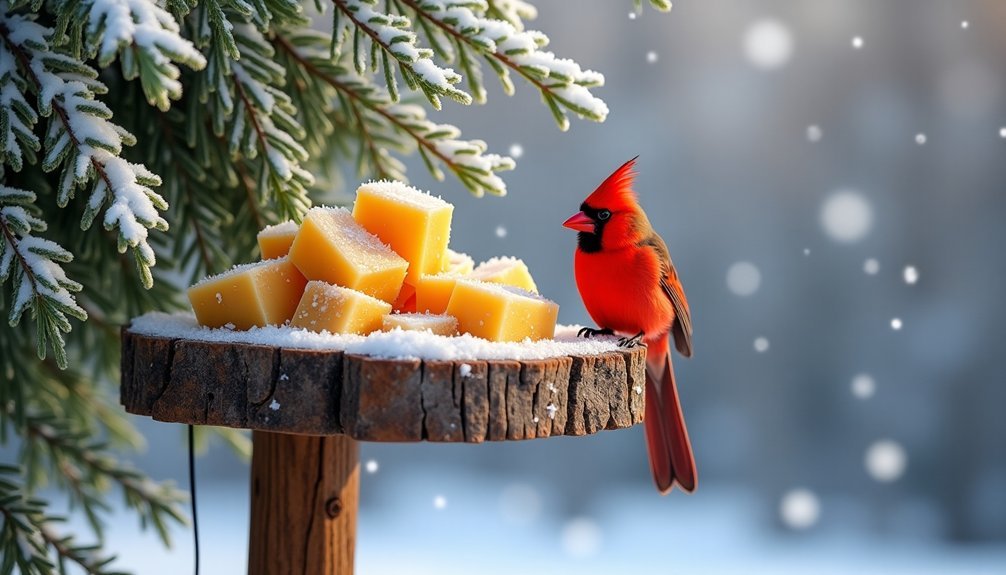
While many bird enthusiasts reduce their feeding efforts during winter, this season actually represents the most crucial time to maintain your suet stations.
Birds face a perfect storm of challenges: their energy requirements skyrocket as temperatures plummet, while natural food sources become scarce.
Winter creates a survival paradox for birds: higher energy needs precisely when food is hardest to find.
Suet provides a high-energy solution that's easily metabolized, helping birds generate essential body heat. When snow and ice cover natural feeding grounds, your suet feeder becomes a lifeline.
The rich fat content helps birds build important reserves to survive long, cold nights when they can't feed. Suet cages are particularly versatile options that can accommodate various bird species visiting your yard.
Without these supplemental energy sources, winter mortality rates climb considerably.
The Science Behind Homemade Suet Recipes
When making homemade suet, you'll need to maintain a proper fat-to-seed ratio of roughly 1:1 to guarantee the mixture holds together while providing balanced nutrition.
You can adapt your recipe based on regional bird populations, using more berries in areas with thrushes or extra nuts where woodpeckers are common.
Understanding the nutritional balance means incorporating proteins, carbohydrates, and fats that help birds maintain their energy levels during cold weather.
For greater variety and nutritional benefit, consider creating multiple types of suet using 1 cup lard as the base ingredient with different seeds and fruits to determine bird preferences.
Fat-to-Seed Ratio Matters
Although many backyard bird enthusiasts focus on ingredient selection, the precise ratio of fat to seeds in your suet recipe often determines its effectiveness.
Getting this balance right guarantees birds receive maximum energy while still being able to consume the suet properly.
When preparing your homemade suet, remember these critical ratio guidelines:
- Start with 1:1 – Begin with equal parts fat and dry ingredients for a baseline consistency.
- Adjust for climate – Increase fat content to 60% in colder regions; reduce to 40% in warmer areas.
- Consider bird size – Smaller birds prefer more seeds and less fat for easier feeding.
- Test consistency – Your finished suet should hold together firmly when cool but not crumble when touched.
This balance provides birds with proper nutrition while preventing spoilage and structural issues in your suet cakes. Suet is particularly valuable for birds as it helps them generate body heat during cold winter months when natural food sources are scarce.
Regional Recipe Adaptations
Across North America, backyard birds face dramatically different conditions that demand region-specific suet formulations.
If you're in the South, you'll need recipes that resist melting, often using less beef fat and more peanut butter or cornmeal to maintain stability in higher temperatures. Store your prepared suet in the freezer until needed to prevent spoilage in warmer climates.
Northern bird enthusiasts should focus on maximum calories with higher fat content, which helps your feathered visitors maintain body heat during frigid winters.
Consider incorporating regional ingredients that match local birds' natural diets—more dried berries for areas with fruit-loving species, extra nuts for woodpecker-heavy regions.
Remember to adapt your feeding schedule to your climate. While suet is typically offered from December to April in most areas, you may need to adjust based on your local bear activity and temperature patterns.
Nutritional Balance Basics
Creating the perfect suet for your backyard birds isn't just about regional adaptations—it's about understanding the science of avian nutrition. Birds require specific nutrients to thrive, especially during winter when natural food sources are scarce.
Your homemade suet should balance these essential elements:
- Fats – Provide concentrated energy through lard, beef fat, or coconut oil, vital for cold-weather survival.
- Proteins – Include peanut butter, nuts, or mealworms to support muscle maintenance and overall health.
- Fiber – Add cornmeal and oats to aid digestion and provide sustained energy.
- Calcium – Incorporate crushed eggshells, particularly valuable during nesting season.
Remember to avoid salt, artificial additives, and excess moisture which can harm birds or promote mold growth. Unsaturated fats, such as those found in peanut butter, significantly improve digestibility of tallow-based suet mixtures for birds.
Adjusting your recipe seasonally guarantees you're meeting your feathered visitors' changing nutritional needs.
Selecting the Right Suet Feeder for Your Space
Choosing the right feeder style for your garden dramatically affects which winter birds you'll attract, with options ranging from tail prop designs for woodpeckers to upside-down models that favor nimble nuthatches.
You'll want to weigh both material durability and your local climate when selecting between plastic, wood, or metal mesh feeders that can withstand seasonal challenges. Metal suet cages are particularly cost-effective while providing reliable access for many bird species.
For best results, place your feeder near windows for easy viewing but position it correctly to prevent bird collisions while ensuring protection from predators.
Feeder Styles Compared
The right suet feeder can transform your backyard bird-watching experience by attracting specific species while deterring unwanted visitors. Different designs serve various purposes, from attracting woodpeckers to accommodating multiple birds.
- Tail prop feeders – Support smaller woodpeckers and clinging birds, providing a natural feeding position that mimics tree-trunk foraging.
- Suet log feeders – Resemble natural bark with holes for suet plugs, appealing specifically to woodpeckers while creating a rustic look. These feeders encourage birds to engage in natural foraging behavior as they probe the holes, similar to how they would search for insects in tree bark.
- Downward-facing cage feeders – Favor agile birds like nuthatches while discouraging starlings and grackles.
- Two-cake feeders – Accommodate larger birds such as pileated woodpeckers and provide more feeding space for multiple visitors.
Cedar and recycled plastic offer superior durability compared to painted pine, ensuring your feeder withstands winter conditions year after year.
Optimal Placement Strategies
When you hang your suet feeder determines which birds visit and how safe they'll remain throughout winter.
Mount feeders at least 5 feet high to deter predators while guaranteeing they're still accessible for refilling.
Position your suet station in a shaded spot to prevent melting, especially during occasional winter warm spells.
Place it about 10 feet from trees or shrubs, offering birds quick refuge between feeding visits.
For collision prevention, avoid hanging feeders within 3 feet of windows.
Consider installing baffles to thwart hungry squirrels and raccoons.
Keep suet feeders at least 25 feet from seed feeders to reduce competition.
In colder regions, a location with morning sun can benefit visitors, but guarantee adequate protection from harsh elements.
Remember to check feeders regularly and clean them biweekly.
Providing different suet varieties with ingredients like insects or fruit will attract a more diverse range of bird species to your feeding station.
Winter Birds That Rely on Suet Feeders
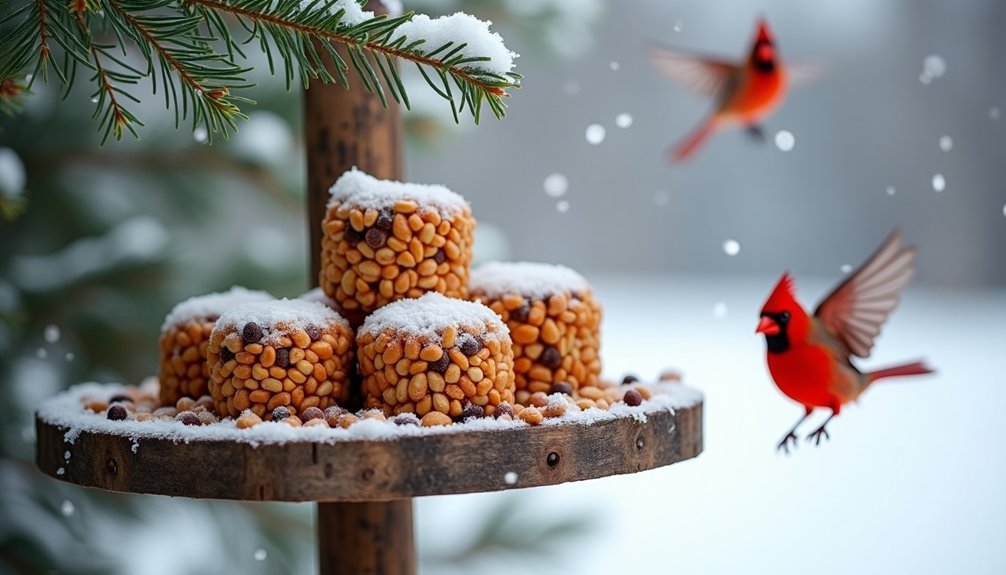
During harsh winter months, many bird species become particularly dependent on suet feeders for survival.
When insects disappear and natural food sources dwindle, your suet offerings become critical energy sources that help birds maintain their body temperature in freezing conditions. Suet provides essential high-quality fat that birds need during cold weather.
You'll likely attract:
- Woodpeckers – Downy and Red-bellied varieties will become regular visitors, often clinging vertically to your feeder.
- Chickadees and Titmice – These small, active birds rely heavily on high-calorie suet to fuel their fast metabolisms.
- Nuthatches – Both White-breasted and Red-breasted nuthatches will acrobatically feed upside-down at your station.
- Wrens and Blue Jays – These opportunistic feeders appreciate the protein-rich supplement when other food is scarce.
Strategic Placement of Your Suet Station
Proper placement of your suet feeder can dramatically increase bird visits while minimizing potential problems.
Position feeders between 4-6 feet high to protect birds from predators, and either less than 3 feet or more than 30 feet from windows to prevent collisions.
Avoid direct sunlight to prevent suet from melting and becoming rancid.
Hang your feeder near shrubs for bird comfort, but not close enough for squirrels to jump across.
Consider installing baffles for additional squirrel protection.
Keep suet feeders separate from busier feeding stations to reduce competition, especially for shy species.
During winter, guarantee your station remains accessible despite snow accumulation.
If you're in an urban setting, window-mounted feeders can work well while allowing you to enjoy close-up views of your feathered visitors.
Try placing feeders near trees where birds naturally congregate as they will communicate food availability to other birds in the area.
Protecting Your Suet Feeders From Unwanted Wildlife
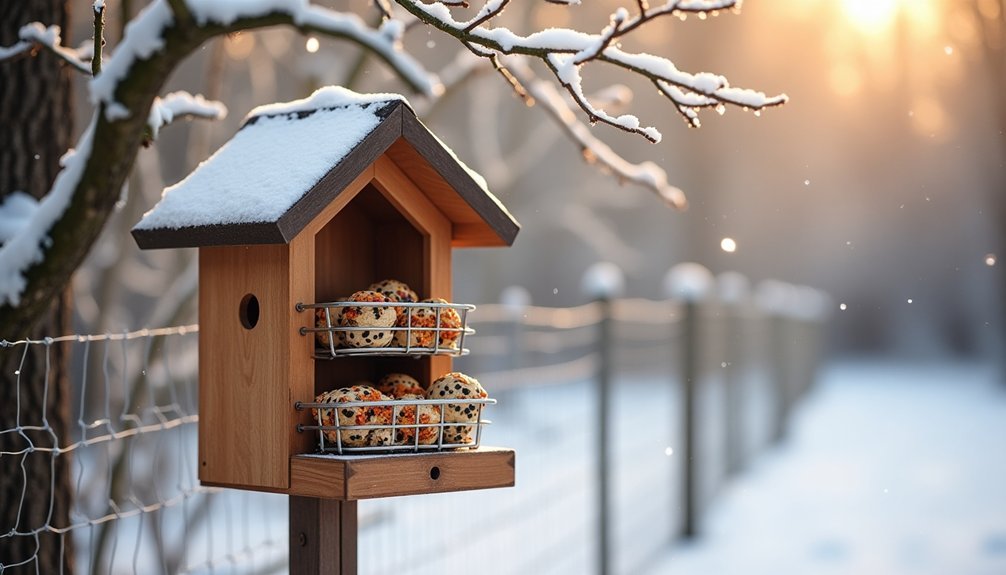
Your suet station requires protection from persistent squirrels who can empty feeders in hours and damage equipment with their gnawing.
Deer might browse nearby plants or bump into your feeder setup, so consider installing your station away from their common paths or using deterrent sprays.
You'll also need strategies to guard against predators like hawks that target feeding birds and outdoor cats that can decimate backyard bird populations.
Starlings pose another significant challenge as they can quickly dominate feeding areas and consume suet excessively, making upside-down feeders a worthwhile investment to allow woodpeckers and other desirable birds better access.
Squirrel-Proofing Your Feeders
While many bird enthusiasts welcome the sight of colorful winter birds at their suet stations, uninvited squirrels can quickly turn a peaceful feeding scene into a frustrating battle.
Effective squirrel-proofing doesn't just protect your bird food—it enhances the entire winter bird-watching experience.
The most successful squirrel-proof suet feeders incorporate these features:
- Weight-activated mechanisms that close access ports when triggered by a squirrel's heavier weight
- Chew-resistant materials to withstand determined gnawing attempts
- Cage designs with small openings that allow birds access while keeping squirrels out
- Proper placement at least 18 inches away from structures that squirrels might use as launching points
Remember that easy-to-clean feeders with detachable components will help maintain effectiveness throughout the winter season. Some premium models even feature a TRULY SQUIRREL PROOF™ mechanism that allows the openings in the shroud to align perfectly with feeding ports for birds while blocking access to squirrels.
Managing Deer Access
Squirrels aren't the only wildlife that can disrupt your winter bird feeding station—deer can become unexpected visitors to suet feeders, creating unique challenges for backyard bird enthusiasts.
To deter these larger visitors, mount your suet feeders at least 6 feet high and use cage-style designs that prevent deer access while allowing birds to feed.
Place feeders near windows or areas with regular human activity, as deer typically avoid these spaces. This approach also helps reduce the risk of collision risks for birds when feeders are positioned close to windows.
For the suet itself, opt for recipes with deer-discouraging ingredients like thistle seeds rather than corn or sunflower seeds. Use peanut butter or lard as binding agents and add protein-rich fillers like oats or sesame seeds.
Clean up fallen suet regularly and only put out what birds will consume daily to minimize attraction.
Remember to check local regulations, as some areas have restrictions on wildlife feeding.
Cat and Hawk Protection
Birds gathering at suet feeders can inadvertently become targets for cats and hawks, creating a challenging situation for bird enthusiasts who want to provide nourishment without endangering their feathered visitors.
You'll need strategic defensive measures to keep your winter birds safe while they feed.
Install protective barriers on your suet feeding station:
- Mount feeders on poles with downward-facing metal cone predator guards to prevent climbing predators.
- Position feeders at least 15 feet away from trees and shrubs where hawks can perch or cats can hide.
- Consider motion-activated deterrents like ultrasonic devices or sprinklers that activate when predators approach.
- Temporarily remove feeders if you notice hawk activity, reinstalling them after a few days when smaller birds return.
These precautions create a safer feeding environment while maintaining the crucial nutrition birds need during winter months. For optimal protection, hang your feeders on a wire at least 8 feet above the ground where cats cannot reach them.
Maintaining Your Suet Feeders in Freezing Conditions
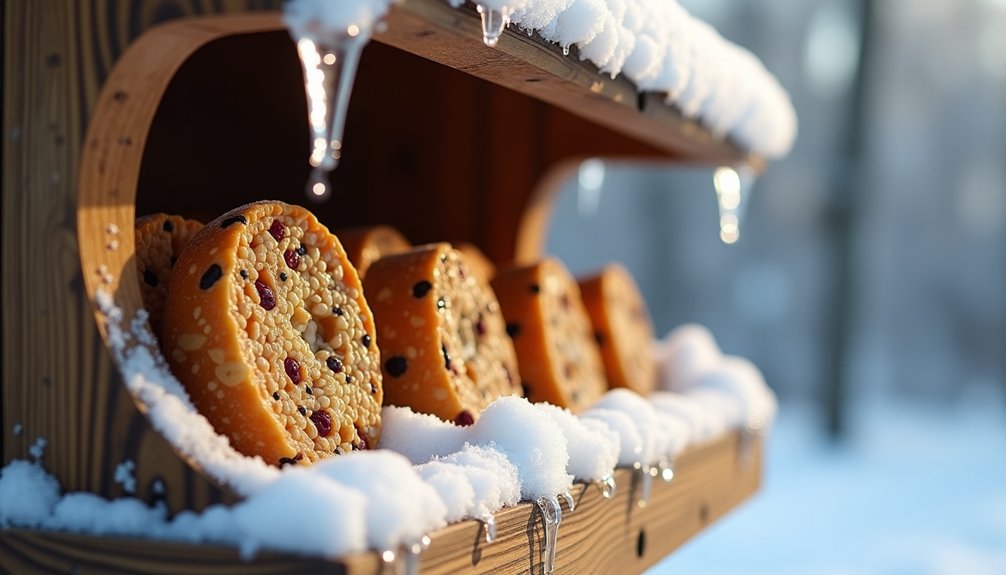
As temperatures plummet during winter months, your suet feeders require special attention to keep them functional and accessible to hungry birds.
Regularly clear snow and ice from feeder openings to guarantee birds can reach the food. For optimal bird health, remove frozen seeds and debris that could promote mold growth on your suet blocks. Replace old suet promptly to prevent bacterial growth and spoilage that could harm your feathered visitors.
During extreme cold snaps, provide extra suet as birds need additional energy to maintain body heat. Store unused suet in your freezer to preserve freshness.
Clean feeders frequently with vinegar or mild bleach solution to maintain hygiene.
Choose weatherproof feeders with protective roofs and durable materials like wire mesh or metal.
Place them under tree limbs for additional shelter, but far enough from trunks to deter squirrels and raccoons from reaching this valuable winter food source.
Complementary Feeding Options for a Complete Winter Buffet
While suet offers essential fat content for winter survival, a truly effective bird feeding station provides multiple nutritional options to attract diverse species.
Diverse feeding options transform your backyard into a winter sanctuary for birds seeking varied nutrition.
Creating a complete winter buffet guarantees you'll support a wider variety of feathered visitors during the coldest months.
- Black-oil sunflower seeds – These high-energy seeds will attract cardinals, chickadees, and blue jays to complement your suet-loving woodpeckers.
- Nyger seed feeders – Add specialized thistle feeders to welcome finches and siskins that won't visit your suet station.
- Peanut options – Offer whole or shelled peanuts in mesh feeders to provide protein-rich alternatives that nuthatches and jays will appreciate. During severe winter conditions, these high protein foods become even more valuable for birds struggling to maintain their body temperature.
- Fresh water source – Don't forget a heated birdbath, as clean water becomes scarce during freezing temperatures and will draw birds even more reliably than food.
Creating Bird-Safe Zones Around Your Suet Station
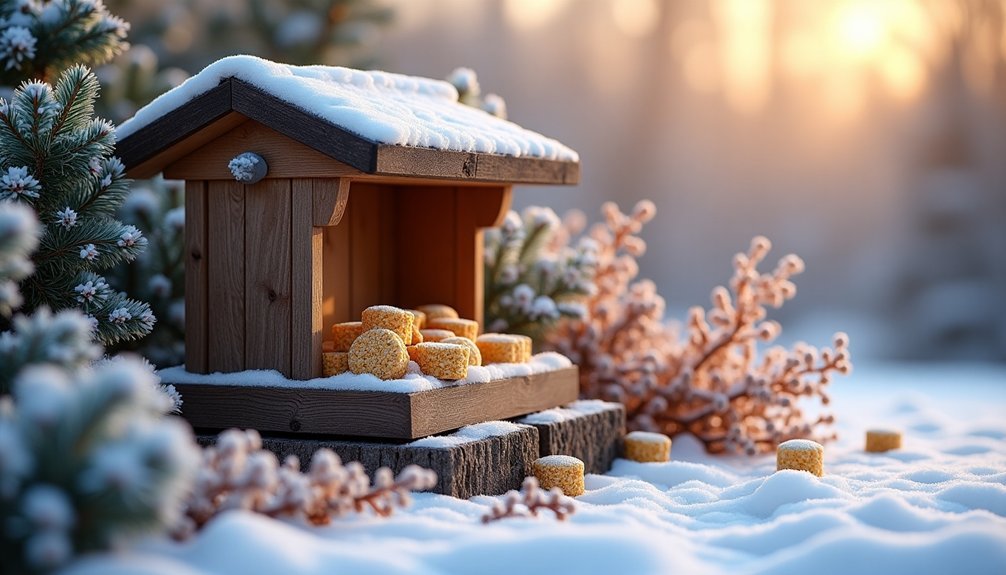
Beyond food selection, the physical layout of your feeding area plays an essential role in attracting and protecting winter birds.
Position your suet feeder near evergreens or dense shrubs that provide immediate shelter from predators and harsh weather.
Install feeders at least 30 feet from windows or within 3 feet to prevent bird collisions. Use baffles or squirrel-proof designs to deter unwanted visitors, and place feeders high enough to discourage ground predators. Consider using strong pole mounts for your suet feeders to ensure they remain stable during winter storms.
For additional protection, create brush piles nearby as escape cover for ground-feeding species.
Consider adding native evergreens if your yard lacks natural shelter.
Make certain your station is visible for easy maintenance and enjoyment.
With strategic placement and protective features, you'll create a safe haven that birds will frequent throughout winter.
Seasonal Suet Recipes That Birds Love
Creating your own seasonal suet recipes gives you complete control over what birds will find at your feeding station.
Winter recipes should focus on high-fat ingredients that provide essential energy during cold months while avoiding ingredients that spoil quickly.
- Basic Winter Suet: Melt beef suet or lard slowly over low heat, strain out impurities, then mix in peanut butter, oats, and sunflower seed hearts before cooling in molds.
- Cranberry Delight: Add dried cranberries to your basic suet mix for natural sweetness that attracts a variety of species.
- High-Energy Blend: Increase the ratio of peanut butter and add extra sunflower hearts for birds needing more calories during extreme cold.
- Bear-Safe Option: Use vegetable shortening instead of animal fat, especially if you'll continue feeding into early spring. Remember to completely remove your suet feeders after April 1st to prevent unwanted bear encounters in your yard.
Photographing and Identifying Visitors to Your Suet Feeders
Who wouldn't want to capture stunning images of the colorful visitors to their winter suet station?
Position your feeder where morning sunlight hits it, and use a tripod with remote shutter release to eliminate camera shake. Longer focal lengths up to 700mm let you photograph birds without startling them.
Set your camera to Aperture Priority with continual focus and burst mode to track fast-moving birds. Hanging suet cakes in specialized cages will effectively attract woodpeckers and nuthatches to your photography setup.
Place your feeder near branches that serve as natural perches for better composition. Keep an identification guide handy and notice distinctive features like beak shape and plumage patterns. Binoculars help with identification without disturbing your subjects.
Consider participating in Project FeederWatch to contribute your observations to citizen science while learning to identify woodpeckers, chickadees, nuthatches, and other suet-loving winter residents.
Frequently Asked Questions
How Long Does Homemade Suet Last Before Spoiling?
Homemade suet typically lasts 1-2 weeks at room temperature, up to a month refrigerated, and several months when frozen. You'll need to monitor for signs of spoilage like odor changes or mold growth.
Can I Use Bacon Grease in My Suet Recipe?
Yes, you can use bacon grease in your suet recipe. Just render it first to remove excess salt. It's best used in winter as it melts in warm weather. Birds love the distinctive flavor!
Do Birds Become Dependent on Suet Feeders?
No, birds don't become dependent on suet feeders. Research shows they naturally balance feeder use with foraging. You'll simply be providing a helpful supplemental food source that birds can take or leave.
Should Suet Feeding Continue During Spring and Summer?
Yes, you can continue suet feeding in spring and summer. Just use no-melt suet in shaded areas, replace it often, and watch for spoilage. Many birds will still appreciate this high-energy food source.
How Do I Prevent My Suet From Melting in Mild Weather?
To prevent your suet from melting in mild weather, use no-melt formulations, place feeders in shaded areas, freeze suet before use, offer smaller portions, and replace it regularly to maintain freshness.
In Summary
Your suet station is now ready to become a winter haven for your feathered neighbors. You'll soon witness a delightful parade of woodpeckers, chickadees, and nuthatches enjoying your thoughtful offering. Remember, you're not just feeding birds—you're helping them survive the season's harshest months. Keep your feeders clean, your recipes fresh, and your camera ready for those magical moments of connection with nature.

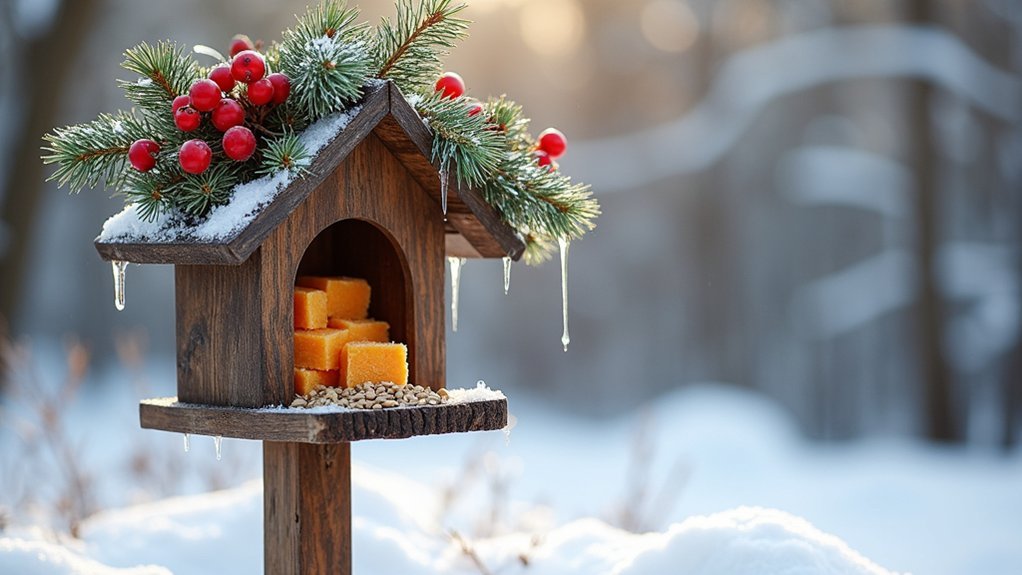



Leave a Reply